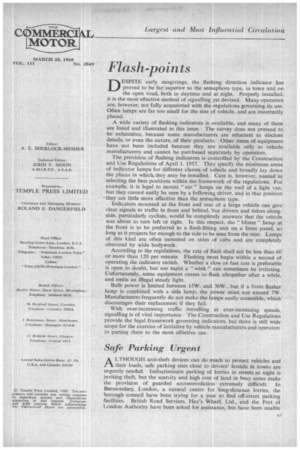Flash-points
Page 37

If you've noticed an error in this article please click here to report it so we can fix it.
DESPITE early misgivings, the flashing direction indicator has proved to be far superior to the semaphore type, in town and on the open road, both in daytime and at night. Properly installed, it is the most effective method of signalling yet devised. Many operators are, however, not fully acquainted with the regulations governing its use. Often lamps are far too small for the size of vehicle, and are incorrectly placed. .
A wide variety of flashing indicators is available, and many of them are listed and illustrated in this issue. The survey does not pretend to be exhaustive, because some manufacturers are reluctant to disclose details, or even the nature, of their products. Other items of equipment have not been included because they are available only to vehicle manufacturers and cannot be purchased separately by operators.
The provision of flashing indicators is controlled by the Construction and Use Regulations of April 1, 1957. They specify the minimum areas of indicator lamps for different classes of vehicle and broadly lay down the places in which, they may be installed. Care is, however, needed in selecting the best positions within the framework of the regulations. For example, it is legal to mount " ear " lamps on the roof of a light van, but they cannot easily be seen by a following driver, and in that position 'they are little more effective than the semaphore type.
Indicators mounted at the front and rear of a large vehicle can give clear signals to traffic in front and behind, "but drivers and riders along side, particularly cyclists, would be completely unaware that the vehicle was about to turn left or right.. In this respect, the " blister " .lamp at the front is to be preferred to a flush-fitting unit on a front panel, so long as it projects far enough to the side to be seen from the rear. Lamps of this kind are often mounted on sides of cabs and are completely obscured by wide bodywork.
According to the regulations, the rate of flash shall not be less than 60 or more than 120 per minute. Flashing must begin within a second of operating the indicator switch. Whether a slow or fast rate is preferable is open to doubt, but too rapid a " wink " can sometimes be irritating. Unfortunately, some equipment ceases to flash altogether after a while, and emits an illegal steady light.
Bulb power is limited between 15W. and 36W., but if a front flasher lamp is combined with a side lamp, the power must not exceed 7W. Manufacturers frequently do not make the lamps easily accessible, which discourages their replacement if they fail.
With ever-increasing traffic travelling at ever-increasing speeds, signalling is of vital importance. The Construction and Use Regulations provide the legal framework governing indicators, but there is still wide scope for the exercise of initiative by vehicle manufacturers and operators in putting them to the most effective use.




















































































































